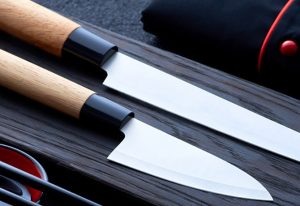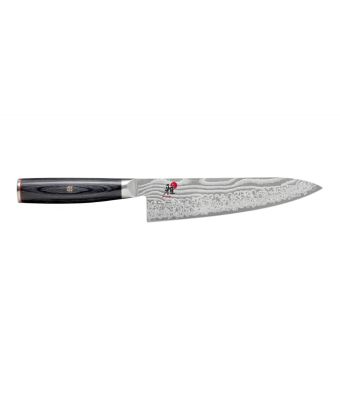The Ultimate Guide to Buying Japanese Kitchen Knives

Japanese kitchen knives (sometimes known as hōchō or bōchō) are among the finest that you can buy, usually made from much tougher steel than their European counterparts, which makes them thinner and lighter, but most importantly, sharper.
These types of knives are often used by the top chefs, as they allow for a much cleaner cut, which doesn’t tear or damage their ingredients, but why not bring that precision and class to your own kitchen?
Here’s our ultimate guide to everything you need to know when purchasing Japanese kitchen knives.
In this guide:
- The Intro
- The Anatomy
- Type of Knives
- Things to Consider
- Brands
Anatomy of a Japanese Kitchen Knife
To begin with, we’ll be taking a look at exactly what sets a Japanese knife apart from a Western one.
Generally speaking, European or American knives are more suited to the heavy-duty tasks, while a Japanese knife is usually better for the more delicate and specialised tasks.
One of the big differences between Japanese and Western knives is that Western knives usually have a ‘bolster’ in between the handle and the blade of the knife, but Japanese knives generally don’t.
The bolster is used to add weight to the knife and balance it out, but Japanese knives are already balanced, so this extra weight isn’t needed.
The handles of Japanese knives are more likely to be made from wood too and are often larger to balance out the weight that is lost from not having a bolster.
In terms of the blade, Japanese knives are usually flatter and often with a single bevel, which means that the blade only tapers to one side, rather than both.
The specifics of the blade depend on exactly what kind of knife it is, which we’re going to quickly run through next.
Types of Japanese Knife
Santoku
One of the best-known types of Japanese knives, the santoku can be used for a range of ingredients such as fish, vegetables and meat and is used to mince, dice and slice.
Their blades are usually between five and eight inches long, with a flat edge and a blade curved at about 60 degrees which looks a little similar to a traditional chef’s knife.
They can be used for a variety of cutting and chopping tasks, although the shortness of the blade means they’re not great for slicing larger pieces of meat and fish.
Gyuto
Gyuto literally translates as ‘beef sword’, which refers to its origins preparing raw meat and fish, although it makes for a good general all-purpose knife, often used for the preparation of Western dishes and is perhaps the type of knife which most closely resemble a Western chef’s knife.
The edge has a gentle curve toward the point, which makes it ideal for cutting tougher produce such as fruit and vegetables in a rocking motion, with more contact with the chopping board, meaning less fatigue for the user.
Usually measuring around 8 to 12 inches, these knives are lightweight and ideal for more precise tasks, but perhaps not for larger and tougher ingredients.
Sashimi
Sashimi refers to the type of raw fish used in Japanese sushi, which is generally what this knife is used for, perfect for filleting, portioning and slicing.
These knives are usually only bevelled on one side, which gives them a much finer and sharper edge, with a very flat back to give more support when in use.
As well as for sushi and fish, they can also be used as a substitute for a carving knife for other meats too.
Usuba
While an usuba knife may look like a meat cleaver, they are in fact much thinner and are more likely to be used in the preparation of fruit and veg.
They give perfect, clean slices without causing any damage, which is ideal in Japanese cooking where the presentation of the food is almost as important as the taste.
Deba
Deba knives are specifically used for preparing fish and have a sharp point due to their curved tip and spine.
Like the sashimi knife, the deba is single bevelled, but is thicker than most other Japanese kitchen knives, meaning it can easily chop through some of the larger fish bones. Deba knives also have a curved edge which makes them ideal for mincing.
Things to Consider
So what are the main things that you should be looking for when you’re deciding which Japanese knives to buy?
Steel
The type of steel that the knife is made from is one of the most important things to consider. The steel used in Japanese knives is renowned for its toughness, sharpness, edge life and quality and ease of sharpening, but each knife is slightly different.
For example, at the most expensive end of the spectrum, you can get super high carbon steel (also known as blue or white steel), which are much harder, but also can chip more easily and require a lot more maintenance.
You’re more likely to be looking for an entry-level Japanese knife, which are usually made from stainless steel.
Stainless steel knives are more durable and won’t rust as easily, and it’s really not necessary to shell out on a super expensive knife if you’re just starting out your collection of Japanese knives.
Handle
The shape of the handle is very important in terms of how the knife is balanced and how it feels in your hand.
It’s very important that you feel comfortable using your knife, not only to make it easier to use but also to ensure that you don’t cause any accidents.
Make sure to hold the knives before making a purchase to ensure that the handle isn’t too big or too small for your hands, as they will be more difficult to control otherwise.
Use
It’s also important to carefully consider how you’re going to be using the knife, as they all have different purposes.
For example, if you’re going to be filleting and preparing fish, you’ll probably just want a sashimi or deba knife.
If you’re looking for something to tackle a wider range of kitchen tasks though, consider whether you’ll be spending more time preparing vegetables, in which case a knife with a curved edge will probably be better, allowing you to chop in a rocking motion, or if you’re more likely to be preparing meat, you might prefer a straighter blade.
In addition, shorter blades will be better for smaller, more fiddly items or food, while you’d be better with a longer blade for any larger items.
Brands
Here’s a quick rundown of some of the Japanese knife brands that we stock here at Kitchen Knives.
Tamahagane
Tamahagane (coming from the words tama ‘round and precious’ and hagane ‘steel’), refers to a special type of Japanese steel, often used in the central cores of samurai swords, which had to be extremely sharp and strong.
The knives, in collaboration with the Arai workshop in Oogata City in Nigata prefecture, are made with the finest materials, such as Hitachi and Takefu Special Steels to deliver knives with a sharpness to that maintains the integrity of even the toughest products.
Kasumi
Kasumi Knives are produced in the Sumikama Cutlery factory in Seki, which was the first manufacturer to use folded Damascus steel wrapped around a VG-10 core, which is a practice which has been replicated by many others since.
They also specialise in using highly sought-after VG-10 stainless steel, a steel mix of molybdenum, chromium, vanadium and cobalt, which holds its edge better than any other.
Masahiro
As one of the most prestigious brands in Japan (known as one of the ‘Three Ms’ along with Masamoto and Misono), Masahiro are perhaps best known for their MV-H range, made from a heat, moisture and solvent resistant resin handle.
Bunmei
These traditional Japanese knives are made with a slip-resistant bamboo handle and a one-sided razor-sharp edge.
Mainly used for raw fish and meat for sushi and sashimi, Bunmei knives are available in a variety of sizes.
Now that you have a better idea of what to look out for when it comes to Japanese kitchen knives, be sure to check out our full range of
traditional and premium Japanese knives here at Kitchen Knives.

